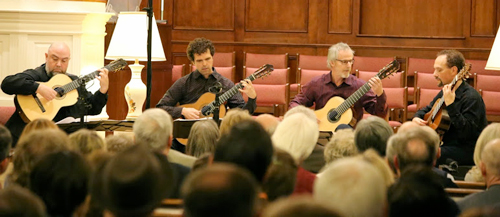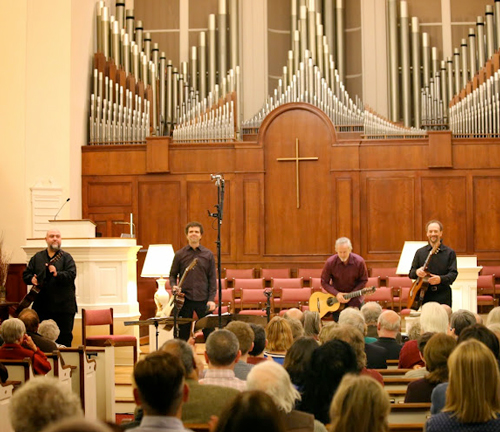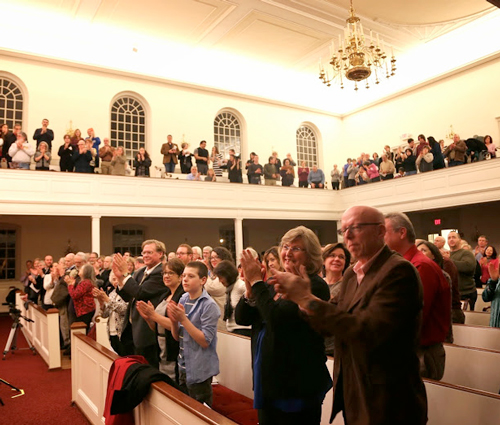by Daniel Hathaway

As Michael Bane, a doctoral candidate at Case, noted in his informative pre-concert lecture, that repertoire is a recent development because the guitar quartet itself hasn’t been around all that long. Nineteenth century attempts to create an ensemble of different sized guitars that paralleled the string quartet didn’t catch on. The Los Angeles Guitar Quartet has played a leading role in creating a body of music for four equal guitars, and shining examples of that ensemble’s possibilities were on display on Saturday.
Just last week, LAGQ released its most recent CD, New Renaissance, featuring a suite of music from the time of Cervantes inspired by an earlier collaboration with the British actor John Cleese. The Quartet began its concert with a healthy sampling of 16th century Spanish music from that suite with brief narrations from the Don Quixote saga delivered by William Kanengiser.
“Music from the Time of Cervantes” was a delightful half-hour long collection of short dances, variations and character pieces by Luys de Narvaéz, Antonio Martín y Coll, Juan Arañez, Luys Milan, Juan de Encina and anonymous masters. LAGQ put it across with élan and an impressive range of timbres and colors.
For something new and entirely different, the Quartet turned to Balkan-born composer Dusan Bogdanovic’s Six Ricercars (on a Theme by F.C. da Milano), half a dozen brief contrapuntal essays based on music by the 16th century Papal lutenist. Inventive in their use of African polyrhythms and Balkan asymmetric meters, the pieces demonstrated LAGQ’s sensitive ensemble playing and formed a nice bridge between the world of Cervantes and what was to follow.
That next set was entitled “Five Guitar Heroes,” and tilted the program in the direction of jazz, pop and world music. Ralph Towner’s Icarus, Chet Atkins’ Blue Ocean Echo (incorporating shards of Country Gentleman), Baden Powell’s Samba Novo, and Pat Metheny’s Letter from Home preceded Gerardo Giménez’s zarzuela piece, El baile de Luiz Alonzo, which took LAGQ back to its roots via the works arranger and one of the ensembles original mentors, Pepe Romero. Ingenious arrangements by Kanengiser, M. Tardelli and M. Small brought even more modern guitar sounds into play.
Two extended works followed intermission. In the first, composer Ian Krouse had set himself the task of writing a piece based on Dowland’s Frog Galliard that never ventured out of the twelve pitches available in the key of E Major. That’s more difficult than it sounds, for most pieces that last fourteen minutes or more, as Music in Four Sharps does, depend on venturing away from the home key and finding a convincing way to return at the end. Krouse developed a clever passacaglia-like format of variations over a recurring pattern borrowed from Dowland. When that idea ran out of steam, he turned to Philip Glass-like repetition, which kept things fresh — and safely in E Major — to the end. LAGQ helped hold everyone’s attention with their rapt, concentrated playing.
Three arrangers — William Kanengiser, Ian Krouse and Scott Tennant — were involved in adapting Manuel de Falla’s ballet, El Amor Brujo, for four guitars. Kanengiser launched the project some twenty years ago, and wrote, “What is lost in orchestral color is perhaps gained in the authentic gypsy sonority of the guitar, which de Falla in some way was trying to convey in his original.”
The 22-minute suite — which in this form also omits de Falla’s original mezzo-soprano soloist — works surprisingly well for four plucked instruments, especially in the hands of such guitar masters as John Dearman, Matthew Greif, William Kanengiser and Scott Tennant. The “Danza ritual del fuego” was a high point, of course, but the tango in 7/8 time was lovely in its own understated way.
The big, warm ovation at the end of the de Falla was richly deserved and called for an encore. Having seemingly exhausted all other sonic possibilities, the Quartet turned to something completely elegant in its simplicity. Scott Tennant announced that LAGQ’s performance of the first prelude from Book I of The Well-Tempered Clavier (arranged by Andrew York) would honor Johann Sebastian Bach on his 330th birthday.
Photos by Hubert Kdayssi courtesy of Cleveland Classical Guitar Society.
Published on ClevelandClassical.com March 24, 2015.
Click here for a printable copy of this article





